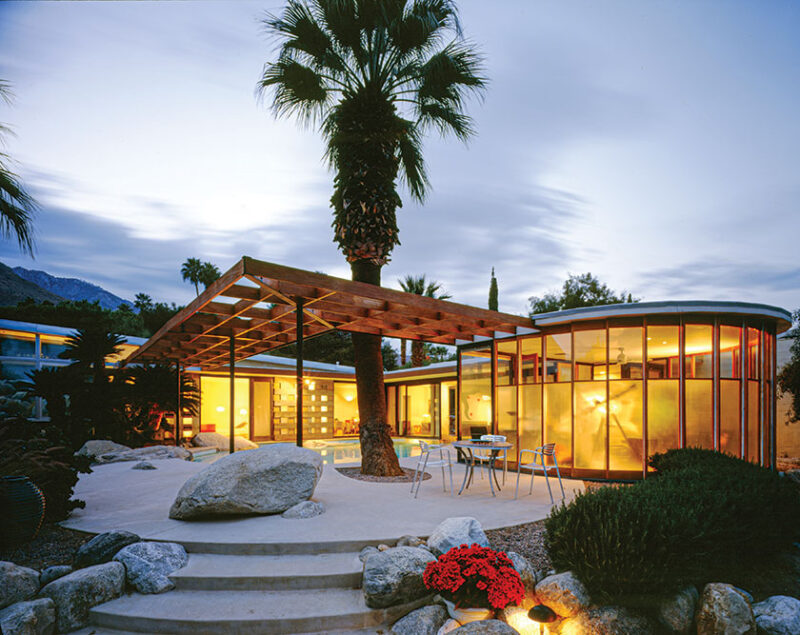On the 25th anniversary of Palm Springs Modern, author Adele Cygelman looks back at her seminal book that was the first to shed a collective light on the desert’s architectural treasures.
While Palm Springs has almost always had a reputation as being a destination for the jet set, it wasn’t always appreciated or identified as a trove of modern architectural design.
“I started hanging out in Palm Springs in 1994, when location scouts, magazine editors and the design-obsessed were all being drawn to the desert by the same modernist siren call,” Adele Cygelman says. “At that point, the only architecture coverage was Joseph Rosa’s book on Albert Frey. Because I was an editor at Architectural Digest at the time, I was introduced to Albert and we ran an article on him, but that was pretty much it until the floodgates opened in 1998 with the publication of major articles about Palm Springs in The New Yorker and Vanity Fair.”


“As I began spending more time in the desert and started to hear about some of the trophy houses that were being restored, such as Kaufmann and Loewy, I realized that there was a bigger story to tell,” Cygelman says. “I will never forget the smile that lit up Stewart Williams’ face when I told him that I was working on a book about Palm Springs modernism. Up until then, no one outside the city had heard of Stewart Williams or William Cody or John Porter Clark or Donald Wexler.”
Cygelman wrote her book Palm Springs Modern, published by Rizzoli, in 1999. It was the first book to celebrate the Mid Century Modern architecture in Palm Springs. It featured more than 15 homes, including The Raymond Loewy House, The Frank Sinatra House and The Arthur Elrod House, to name a few. She says the homes weren’t hard to access at the time. “People were proud to show us their homes. The local architects all assumed that their work had been forgotten, so they were thrilled that someone was taking an interest,” the author says. “It also helped that many of the homes were still in the hands of the original owners. But changes had been made—as people aged in place, wall-to-wall carpets had crept in, as had heavy drapes and shelves full of “tchotchkes” and assorted clutter. So there were some lovely houses we saw that we unfortunately couldn’t photograph. The only house we couldn’t get into was the Bob and Dolores Hope residence on Southridge.”

The book became an instant bestseller and is still in print, “which is a remarkable achievement for a book these days,” Cygelman points out. She is proud of the accomplishment it was then and of its legacy today. “It was the first book to shine a light on this magical place at a pivotal moment in time when some of the original architects and many of the original homeowners were still alive and able to tell their story,” she says. “That the book changed many people’s lives—people who switched careers to focus on design or who moved to the desert to buy a Mid Century Modern home or who became architectural preservationists—or all of the above.”
Photographer David Glomb and I set out in the mid 1990s to document the best examples of residential Desert Modernism at a time when many of the original homeowners and several of the principal architects (Ambassador and Mrs. Walter Annenberg, Max Palevsky, Luella Maslon, Albert Frey, E. Stewart Williams, Donald Wexler, among them) were still around.
The Difference the Decades Make
Author Adele Cygelman describes the Palm Springs of the 1990s.
Palm Springs was like Sleeping Beauty: this beautiful desert graveyard lying dormant under a layer of dust that was slowly being nudged awake. The city was hemorrhaging money as residents were fleeing down valley to Palm Desert and Rancho Mirage. Tumbleweed blew down Palm Canyon Drive. Storefronts were empty and the ones that were open were selling T-shirts and shot glasses. The Tramway Gas Station was a derelict shell. The consignment stores were full of cool 1950s/’60s furnishings that people were throwing out. You could buy any of the best houses for about $350,000 and any of the Alexanders for about $125,000. There was one preservation organization—the Palm Springs Historic Site Preservation Foundation—and that was it. That all started to change in 1999 when the Palm Springs Modernism Committee formed to advocate for preserving Albert Frey’s Fire Station #1.

Curious about Palm Springs architecture? We have a bevy of resources from Palm Springs Architecture to a Palm Springs Travel Guide to a roundup of some of our favorite renovated Palm Springs homes. And of course, don’t forget to follow us on Instagram, Facebook, Pinterest and YouTube for more Atomic Ranch articles, house tours, and ideas!












